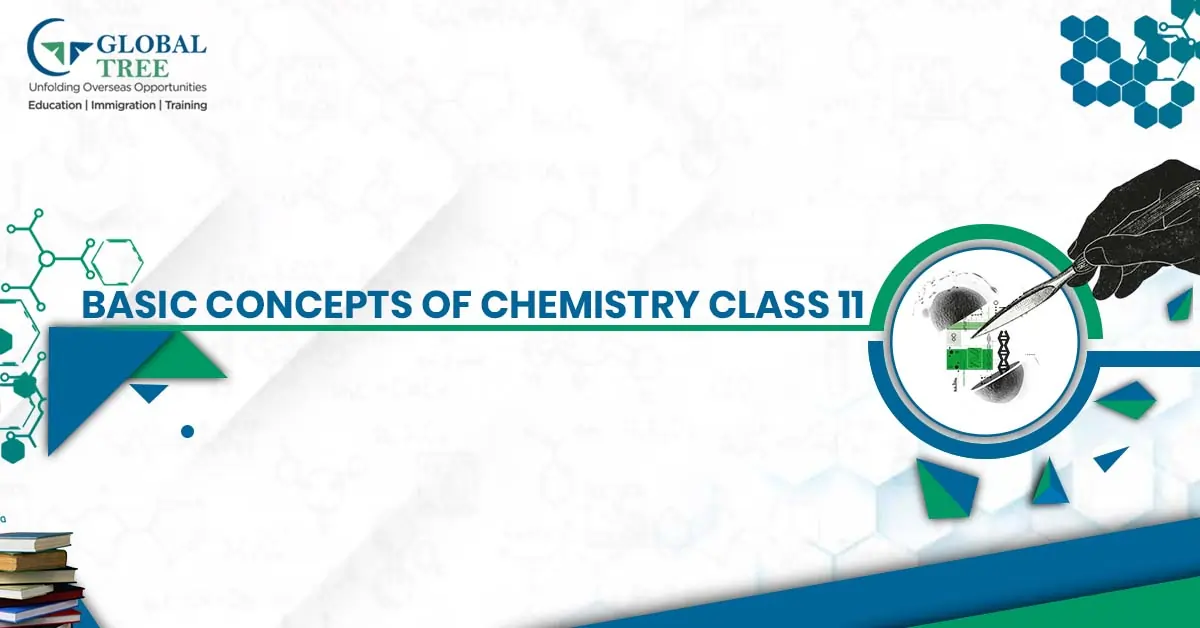Explore Basic Concepts of Chemistry Class 11

- Introduction
- Basic Concepts of Chemistry Class 11
- Importance of Chemistry
- What are the various Branches of Chemistry?
- Matter and Its States - Physical Classification of Matter
- Chemical Classification of Matter
- International System of Units (SI)
- Significant figures
- Laws of Chemical Combinations
- Dalton’s Atomic Theory
- Some Basic Definitions And Terminologies
- Frequently Asked Questions
Introduction
Chemistry - the science of atoms and molecules goes in depth from class 11. If you are a class 11 student who chose science stream, you probably by now, learning chemistry is essential. Learning chemistry seems tricky at the start, but once you get the hang of the basic concepts, it will be more interesting and easier to understand.
Basic Concepts of Chemistry Class 11
Here are the concepts covered in class 11 chemistry.
- The International System Of Units (SI)
- Molecular Mass
- Reactions In Solutions
- Atomic Mass
- Percentage Composition
- Scientific Notation
- Law Of Definite Proportions
- Nature Of Matter
- Mass And Weight
- Significant Figures
(Read More: What is the full form of CO in chemistry? Check out!)
- Law Of Multiple Proportions
- Mole Concept And Molar Masses
- Uncertainty in Measurement
- Avogadro Law
- Dimensional Analysis
- Law Of Conservation Of Mass
- Formula Mass
- Gay Lussac’s Law Of Gaseous Volumes
- Average Atomic Mass
- Laws Of Chemical Combinations
- Dalton’s Atomic Theory
- Importance Of Chemistry
- Empirical Formula For Molecular Formula
- Stoichiometry And Stoichiometric Calculations
- Atomic And Molecular Masses
- Limiting Reagent
- Properties Of Matter And Their Measurement
Before understanding the basic concepts of Class 11 chemistry, here is the overview of the importance of chemistry and branches in chemistry.
Importance of Chemistry
Chemistry isn’t a subject that is restricted for textbooks. Studying chemistry is lucrative in many ways. There are multiple benefits of learning chemistry like you can understand the food you consume and the products we use. The innovations in chemical science courses have revolutionized the medical field. The rigorous research in the chemistry field and drugs led to development of penicillin and streptomycin.
Below are a few reasons to learn chemistry.
- Helps you learn skills for daily life while dealing with chemicals
- More students in chemistry helps in new medicines inventions that can treat fatal diseases
- Knowledge of chemicals can help protect yourselves or others from major dangers.
- Chemistry is a popular course that has a vast range of options available in bachelors and masters.
(Suggested Read: Want to pursue a Biotechnology course? What does it consist of?)
What are the various Branches of Chemistry?
Chapter 1 in Class 11 chemistry deals with 7 branches of chemistry
1. Organic Chemistry
Organic chemistry deals with the study of carbon compounds, particularly hydrocarbons and their derivatives.
2. Inorganic Chemistry
Inorganic chemistry is a complete opposite of organic chemistry. It deals with the study of compounds of all elements except carbon. A major concept in Inorganic chemistry is the study of elements in the Earth Crust.
3. Physical Chemistry
Physical chemistry deals with the fundamental principles dealing with various chemical phenomena. The primary focus in Physical chemistry will be on different laws and theories of the different branches of chemistry.
4. Industrial Chemistry
The name itself is the meaning. Industrial chemistry deals with industrial process
5. Analytical Chemistry
Analytical chemistry deals with Qualitative and Quantitative analysis of different substances.
6. Biochemistry
Biochemistry course deals mostly with chemical changes happening in the bodies of all living beings - humans, plants and animals.
7. Nuclear Chemistry
Nuclear Chemistry is the most interesting branch in chemistry that deals with nuclear reactions. Nuclear fission, Nuclear Fusion, transmutation processes, etc are part of this branch.
Matter and Its States - Physical Classification of Matter
Everything around us, everything in this universe is made of matter, whether it’s solid, liquid, or gas. These are the three main states of matter that you’ll learn about in Class 11.
- Solids have a fixed shape and volume because their particles are tightly packed.
- Liquids have a definite volume but no fixed shape, meaning they take the shape of their container.
- Gases have neither a fixed shape nor a fixed volume. Their particles are far apart and move freely.
In Class 11, you’ll also study changes in states, like how solids can turn into liquids (melting), or gases can turn into liquids (condensation). Below table explains the properties of three states of the matter.
(Know More: Top 10 science project ideas for a perfect score in class 10.)
| Properties | Solid | Liquid | Gas |
|---|---|---|---|
|
Shape |
Definite |
Indefinite |
Indefinite |
|
Volume |
Definite |
Definite |
Indefinite |
|
Arrangement of Molecules |
Arranged orderly |
Free to move within the volume |
Free to move everywhere |
|
Intermolecular force of attraction |
Very high |
Moderate |
Negligible |
|
Intermolecular space |
Very small |
Moderate |
Huge |
|
Expansion on heating |
Very little |
Very little |
Highly expand |
|
Compressibility |
Not compressible |
Not compressible |
Highly compressible |
|
Rigidity |
Very rigid |
Not rigid |
Not rigid |
|
Fluidity |
Cannot flow |
Can flow |
Can flow |
|
Diffusion |
Can diffuse |
Can diffuse |
Can diffuse |
Chemical Classification of Matter
In chemistry, we hear a lot about elements and compounds. Here is a brief overview of elements and compounds.
1. Elements
Elements are simplest forms of pure substances made up of only one type of atom, like oxygen (O) or hydrogen (H). They can’t be split into two or simpler substances by any chemical reactions and methods. There are 114 known elements in chemistry in which 92 occur naturally and rest are artificially prepared.
Elements are further classified into Metal, NonMetal and Metalloid.
2. Compounds
Compounds are substances when two or more different elements are combined in a proper and fixed ratio. For example, Water (H₂O) is a compound that is made from Hydrogen and oxygen.
Understanding how elements combine to form compounds will help you understand chemical reactions better. Well, Do you Love chemistry experiments? Take a chemical laboratory course abroad to broaden your horizons!
3. Homogeneous Mixtures
Homogeneous mixture is a form of mixing which has a similar composition throughout the sample. They are also called solutions. The constituents of these mixtures cannot be viewed even under a microscope. Examples of Homogeneous mixtures are air, seawater, petrol, brass and more.
4. Heterogeneous Mixture
Heterogeneous Mixtures are the complete opposite of the homogeneous mixtures. Heterogeneous mixtures are made up of two or several constituents which have different compositions. The dividing lines between the constituents of these mixtures can be easily visible to the naked eye or sometimes under a microscope. Examples of Heterogeneous mixtures are sugar and sand, chalk powder in water, etc.
International System of Units (SI)
International System of Units also known as Le Systeme International d’Unites in French. It is one of the important concepts of chapter 1 and chemistry class 11.
| Base Physical Quantity | Symbol for quantity | Name of the SI unit | The symbol for SI unit |
|---|---|---|---|
|
Length |
l |
metre |
m |
|
mass |
m |
kilogram |
kg |
|
time |
t |
second |
s |
|
Electric current |
I |
ampere |
A |
|
Amount of substance |
n |
mole |
mol |
|
Luminous intensity |
IV |
candela |
cd |
|
Thermodynamic temperature |
T |
Kelvin |
K |
(Read More: In-demand career options after Theoretical Physics course abroad)
Significant figures
The concept of significant figures explains that the reliability of the measure depends on the number of digits used to represent it. To break it down in a more simpler version, figures that are known with certainty are known as significant figures.
Rules to Determine the number of significant figures
Following the significant figures concept, we have the rules to determine the number of significant figures. Below are the rules:
1. Non-zero numbers are always significant
Example: 7.5 (two significant digits), 7.15 (three significant digits)
2. Zeros between non-zero numbers are significant
Example: 3.098 (four significant digits), 4.002 (four significant digits)
3. Leading zeros (zeros at the start of a number) are not significant
Example: 0.032 (two significant digits), 0.005 (one significant digit)
4. Trailing zeros (zeros at the end of a number) after a decimal point are significant
Example: 18.0 (three significant digits), 18.00 (four significant digits)
5. Trailing zeros without a decimal point are not clearly significant
Example: 1500 could have two or four significant digits (depends on how it's written or measured)
(Note: Finished your Class 10 exams? Here’s a list of courses you can pursue right after your 10th standard!)
6. In scientific notation, the number of significant figures is in the number part, not the exponent
Example: 0.00095 (2 significant digits), 6.023 x 10²³ (4 significant digits)
Laws of Chemical Combinations
| Name of the law | Proposed/Given | Year | Description |
|---|---|---|---|
|
Law of Conservation of Mass |
Antoine Lavoisier |
1789 |
The Law of Conservation of Mass states that” Matter (mass) can Neither be Created Nor Destroyed” |
|
Law of Definite Proportions OR Law of Constant Composition |
Louis Proust |
1799 |
Law of Definite Proportions states that, “A chemical compound always consists of the same elements combined together in the same ratio, irrespective of the method of preparation or the source from where it is taken.” |
|
Law of Multiple Proportions |
Dalton |
1803 |
The law of multiple proportions states that “when two elements combine to form two or more compounds, then the different masses of one element, which combine with a fixed mass of the other, bear a simple ratio to one another.” |
|
Avogadro Law |
Avogadro |
1811 |
Avogadro law states that “Equal volumes of gases at the same temperature and pressure should contain an equal number of molecules.” |
|
Gay Lussac’s Law of Gaseous Volumes |
Gay Lussac |
1808 |
Gay Lussac’s Law states that, “When gases combine or are produced in a chemical reaction, they do so in a simple ratio by volume provided all gases are at the same temperature and pressure”. |
Dalton’s Atomic Theory
Dalton’s Atomic theory in class 11 chemistry is one of the important concepts and can expect questions on this topic in board exams. It is also a key concept in Theoretical physics course that covers quantum mechanics and aerodynamics.
Dalton’s theory states that all substances are composed of small invisible particles known as Atoms. Atoms of the same element have similar shape, size, mass and other properties. And these properties differ for each element.
The atom is the smallest unit of a chemical combination. A group of atoms combine to form compound atoms which are called molecules.
Atoms cannot be created, divided or destroyed in a course of any chemical or physical change.
Some Basic Definitions And Terminologies
- Atomic Mass Unit (amu): This is the unit used to measure atomic mass. It is defined as one-twelfth of the mass of a carbon-12 atom. In other words, 1 amu = 1.66056 × 10⁻²⁴ grams. The term "amu" has now been replaced with "u" (unified atomic mass unit).
- Atomic Mass: This is the average mass of an atom of an element, compared to the mass of a carbon-12 atom, which is taken as 12. It gives us a sense of how heavy an atom is relative to carbon.
- Gram Atomic Mass: This refers to the mass of one mole of an element, measured in grams. The number is equal to the atomic mass of the element, but now in grams.
- Molecular Mass: This is the average mass of a molecule of a substance compared to the mass of a carbon-12 atom. It's like the "weight" of one molecule of a substance.
(Suggested Read: Chemical Laboratory course to study abroad for Indian students)
- Gram Molecular Mass: This is the mass of one mole of a molecule, in grams. It’s the same as the molecular mass but expressed in grams instead of atomic mass units.
- Formula Mass: This is the sum of the atomic masses of all the atoms in a formula unit of a compound. This term is mainly used for ionic compounds, where we look at the mass of the formula unit (not molecules).
- Molar Mass: The molar mass is the mass of one mole of a substance, measured in grams. It tells you how much one mole (6.022 × 10²³ particles) of a substance weighs.
- Molar Volume: This is the volume that one mole of a substance occupies. The units for molar volume are typically liters per mole (L/mol) or milliliters per mole (mL/mol).
- Empirical Formula: This is the simplest formula that shows the ratio of elements in a compound using the smallest whole numbers. For example, the empirical formula of benzene is CH.
- Molecular Formula: This formula gives the exact number of atoms of each element in a molecule of a compound. For example, the molecular formula for benzene is C₆H₆, showing that each molecule contains 6 carbon atoms and 6 hydrogen atoms.
Frequently Asked Questions
1. What are some of the basic concepts in Chemistry?
Some of the basic concepts in chemistry include Atomic number and mass, molecular mass, chemical equation and mole concept.
2. Which chapters should you study first in class 11 chemistry?
Some of the important chapters to begin with are structure of atoms, molecular structure and chemical bonding and thermodynamics.
3. What are some basic concepts of chemistry for class 11 ICSE?
The basic concepts for class 11 chemistry include The International System of Units, Molecular mass, Reactions in Solutions, Atomic Mass, Percentage Composition, Scientific Notation, Law of Definite Proportions.






